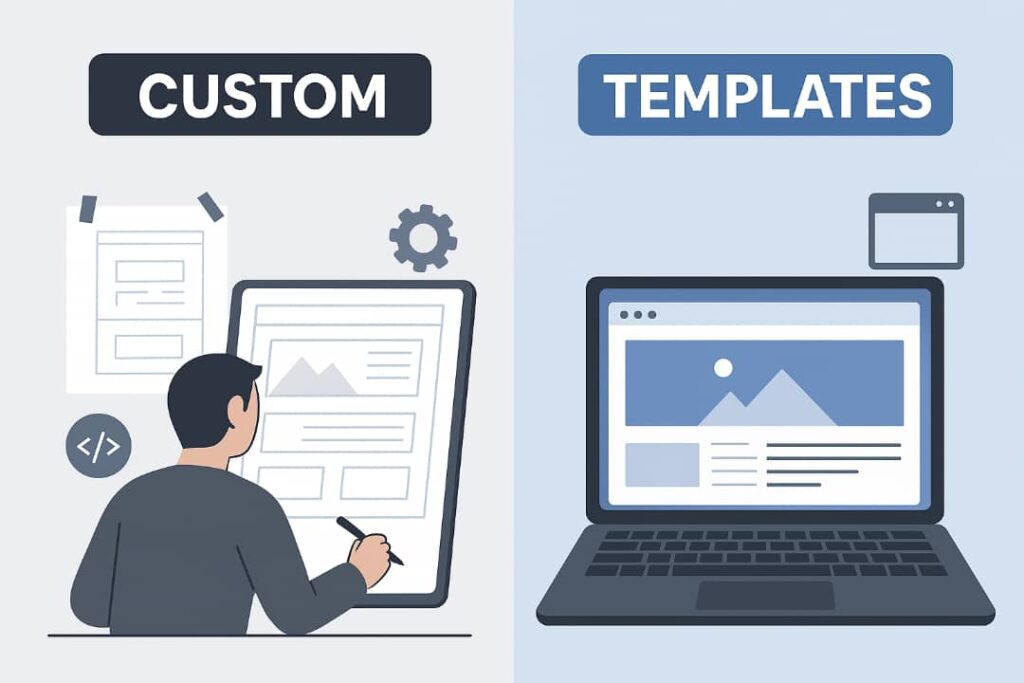
Choosing between a custom website and a template is one of those deceptively simple decisions that can quietly shape your brand, speed to market, and long-term costs. For business and tech leaders making that call, the right answer depends on strategy, scale, and the growth levers you care about most.
In this article, I break it down plainly so you can pick the path that actually supports your goals.
The fast lane: Templates (when speed and budget matter)
Templates (or pre-built themes) are plug-and-play layouts offered by platforms like WordPress, Squarespace, Shopify and many website builders. They’re attractive because they’re fast, cheap, and accessible to non-technical teams.
Pros:
Speed to market. A quality template can get you launched in days rather than weeks. That’s huge when you need to validate a product, chase a time-sensitive campaign, or protect a market window.
Lower upfront cost. Template sites dramatically reduce development time and fees. Good templates often cost between $20–$200, plus modest setup or hosting fees. This makes them ideal for pilots, MVPs, and small businesses.
Built-in maintenance. Popular themes get updates, plugin compatibility fixes, and community support so routine upkeep is easier than with a bespoke stack.
Cons:
Less uniqueness. Templates are, by design, reusable so your site can look like dozens of competitors unless you commit to heavy branding tweaks.
Potential bloat. Some templates pack features you won’t use, which can slow page loads and complicate SEO unless you strip and optimise the code.
Integration limits. If you need bespoke integrations, complex workflows, or unusual UX, a template can become limiting quickly.
The long game: Custom web design (when differentiation and scale win)
Custom design means building from scratch—tailored UX, a tech stack that fits your product, and code optimised for your use cases.
Pros:
Tailored UX and performance. Custom builds allow you to craft conversion flows, accessibility features, and performance optimisations that templates rarely anticipate, improving engagement and trust. They’re easier to optimise for Core Web Vitals and mobile-first experiences, which matter for search visibility.
Scalability and security. A bespoke architecture anticipates scale; high concurrency, microservices or API-first integrations, and security controls aligned with enterprise needs. That reduces technical debt as you grow.
Brand differentiation. If your go-to-market depends on a unique UX or brand story, custom design is essentially an investment in competitive positioning.
Cons:
Higher cost and longer timeline. Custom projects typically start in the thousands (and often exceed this amount for complex platforms). Expect longer delivery cycles and more stakeholder coordination.
Maintenance responsibility. You own updates, patches, and hosting choices unless you buy a managed support plan.
How to decide: a pragmatic checklist for leaders
- Ask the business question first. Are you validating demand or building a defensible digital product? Templates for the former; custom for the latter.
- Measure the cost of being “generic.” If a template’s similarity to competitors would hurt conversions or enterprise deals, that’s a real cost.
- Consider long-term integrations. Will you need CRM, ERP, or custom APIs? If yes, custom is less friction. If your needs are standard (blog, brochure, e-commerce with off-the-shelf payments), templates and platforms like Shopify or WordPress can be efficient and robust.
- Audit performance & SEO before buying a theme. A well-built template can be fast and SEO-friendly, so run Lighthouse/PageSpeed checks and ensure editable meta tags and semantic structure.
- Growth plan. If three-year projections include new product features, higher traffic, or regional expansion, create a migration plan (template → custom) or start with custom development to avoid costly rewrites.
A hybrid path: Start with a solid template and evolve selectively
You don’t always need to pick a side forever. Many fast-moving companies launch with a high-quality, lightweight template and layer custom components as needs crystallise: bespoke checkout modules, custom integrations, or a redesigned homepage that becomes the template for future pages. This staged approach balances cost, speed, and eventual differentiation.
Bottom line
If your priority is speed, proof of market, or extreme cost discipline, start with a focused, well-optimised template and treat it like a product experiment. If your business relies on unique UX, complex integrations, performance at scale, or enterprise credibility, invest in custom design from the start.
Decisions like this are strategic, not purely technical. Match the web approach to where you want the business to be in 12–36 months, and you’ll make the choice that pays off. Need help evaluating a specific template or scoping a custom build for your organisation? BoznG can review a candidate theme or draft a migration checklist tailored to your stack.
Reach out to us at bozng.com